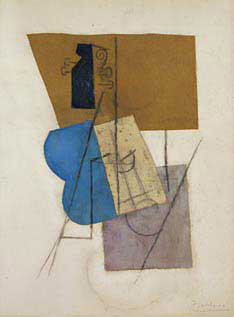
Last Saturday I finally squeezed in a visit to the Menil’s drawing show between naptime and a beautiful, still mosquito-free spring evening watching the kids torment chickens and jump themselves sick on a friend’s trampoline.
I went in with high expectations- it was the Menil, after all; the show was a roster of heavy-hitters, I assume they’re putting on their very best face for the kick-off of the new Menil drawing center, but I left disappointed. It wasn’t a bad show, but I felt, after all, that I could have lived without seeing it.
Drawings in museums are something you have to believe in. They’re not very compelling, displayed behind glass by the hundreds. I recall the "birth of newspaper comics" show at the MFAH, which I was forced into the backbreaking experience of reading a year’s worth of comics, standing. Many of my favorite drawings were never intended for such display at all. Tiny, rough-hewn notes by Claes Oldenburg, Ellsworth Kelly, and Bruce Nauman gave some of the direct insight into the artists’ working processes, something sketches are always good for.
Large scale, minimalist wall drawings by Richard Serra and Sol Lewitt held their own, but were not the best examples of each artist’s work. The Serra, a tarry black swatch of wall was helped enormously by its smell, but its severe geometry was marred by curious circular patches worn in the floor finish, in front of spots where paintings used to hang in a previous installation.
Few of the artists in the show got famous for making drawings, so inevitably, you see the drawings in light of the artists’ "real" work, the work they are known for. At best, they give insight into the more intimate, more playful, or more immediate details of their creative processes, at worst, they’re cheap knock-offs. Of course, exceptions abound: Vija Celmins’ Untitled (medium desert), 1974, is a persnickety graphite landscape that foreshadows a whole slew of figurative conceptual art; if you can tolerate the melodrama, Cy Twombly’s Poems to the Sea, a suite of twenty-five scribbled and slathered white-on-white panes, are all of a piece with his larger work. The cubist drawing/collages are right there at the birth of a new way of seeing, but since they’re on nearly continuous display, it’s easy to pass them by as old friends. Klee, of course, never did anything else.
Rauschenberg is a faithful gusher of artistic production- numerous transfer drawings would be fascinating to puzzle out if they hung on my bathroom wall, but their faint sudoku soup of images and text is too thin to stick you when the rest of this vast show pulls you onwards.
Jackson Pollock struggles to get it right in three pieces on mulberry paper from 1951. Lee Bontecou creates a polished architectural fantasy that would have Kevin Appel drooling. Brice Marden’s Cold Mountain drawings were surprisingly fresh in 1990, and they’re still damnably fluid, giving the lie to postmodern cynicism. Though there are, curiously, only twelve in the vitrine, Fred Sandback’s ultra-refined 14 of 16 Variations of Two Horizontal Lines takes ruled lines to their logical conclusions.
OK, there are more exceptions than I thought. But it’s too much all at once to really appreciate. I’ll guess have to go back.
(note: having had my wrist slapped too many times at the Menil, I didn’t try to photograph this show myself, and the glass over most of the pieces would have ruined it anyway. I’m working on getting press images and will post them asap)
Update: Well, the available press images include none of the pieces I’ve talked about- this is why photography should be allowed in galleries. I’m checking on the Fred Sandback/Donald Judd thing (see comment)- I swear the wall label said Judd, but things were beginning to blur together at that point, so. . .




4 comments
16 Variations is by Fred Sandback. Donald Judd gets enough props without your help.
Fred Sandback is right. Sorry. But where did the other four variations get to?
http://geraldlopezart.com/artwork/213810.html
Gerald Lopez of Corpus Christi–there seems to be not much love for us CCTX artists.
I call us the Country Mouse.
Bill D. why don’t you come and investigate first hand. Maybe we could put you up in a hotel.